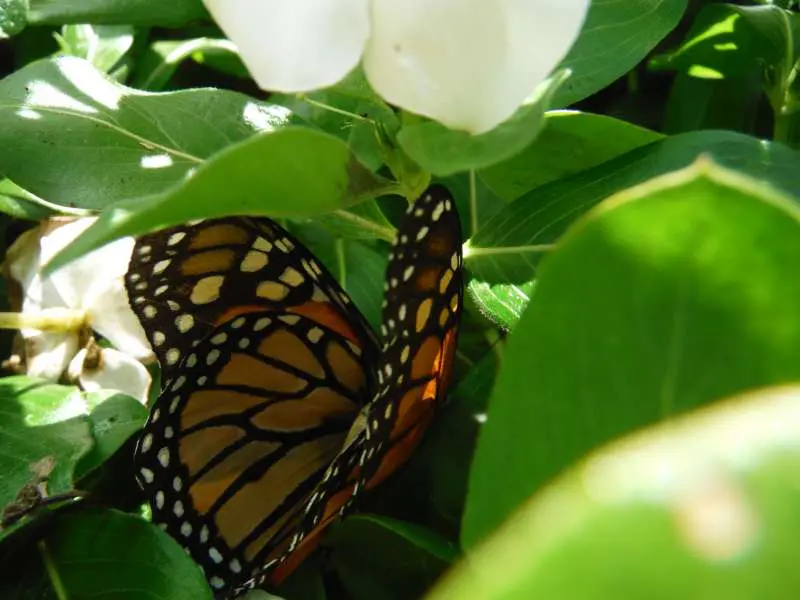How would a road trip without a GPS go for you? Does navigation come pretty naturally to you or are you more directionally challenged? Or perhaps you’re more likely to take an accidental detour caused by missing a turn, due to distraction. While it’s usually easy to navigate familiar places and paths from memory, without any outside help, finding your way around a big city or traveling a new route can make a person feel rather dependent. We use a lot of external resources like maps, GPS, computers, and directions from other people, but monarch butterflies are specially designed with internal “data” and “software” already programmed into their bodies to help guide them as they migrate south for the winter.

Monarch butterflies, scientifically called Danaus plexippus, are very unique for their migration. They hold the record for the longest known insect migration every year. These seemingly delicate little creatures travel long and hard over North America every year, using a relay of 3-4 butterfly generations. Monarchs on the eastern side of the Rockies have an epic journey from near the Canadian border to their special wintering grounds near Mexico City. However, monarchs west of the Rocky Mountains generally just have a relatively short, simple migration from cooler states to California, and these butterflies don’t migrate in some other areas around the world. It’s the monarch butterflies of eastern North America that are known for their amazing migration.
In the spring, these special butterflies start out in Texas, hatching from eggs laid on milkweed plants. This first generation of the year starts traveling north as the spring progresses, following the milkweed bloom and laying the next generation of eggs farther north. One female monarch can lay up to 500 eggs one at a time on a single milkweed leaf, only about 5% of which will make it to adulthood. The next generation matures and continues flying north toward their summer homes in southern Canada. The leisurely trip north takes two or three butterfly generations, with each butterfly living about 4-6 weeks.
As the last generation of the year develops, the change in seasons triggers special information in the DNA for the longest part of migration. These special monarchs, known by scientists as the “migratory generation”, travel all the way from Canada south to Mexico, about a 3,000 mile journey, where they meet in the Sierra Madre mountains. On these few secluded, humid peeks, these butterflies cluster together on oyamel evergreen trees – it makes scientists wonder how all these butterflies “know” to concentrate to this very specific location. Tens of thousands of butterflies will cluster together on one tree to keep warm while they hibernate for a few months. When spring starts to come back, these same butterflies make the final leg of their journey, this time heading north to Texas to lay their eggs that will begin the yearly cycle again.
The Spanish word for butterfly is “mariposa”
Since this migratory generation has such a long trip to make and needs to live all the way through the winter before they lay their eggs, these butterflies have to live up to eight or nine months – much longer than the normal 4-6 weeks. The DNA triggered in this special generation also causes them to wait until after winter and migration are complete to mate and lay eggs. Every monarch has this DNA potential, but it isn’t used unless triggered by the environment. God originally created these butterflies with the potential to adapt as needed. He has equipped them with all the right information to know when and where to migrate – even when blown off course! In Christ, you have everything you need to get where you should go and get back on track when you take a detour. Like frail butterflies made strong and courageous for a long, hard flight, the Lord can take people – frail children of dust – and make us strong and courageous for the battles each of us will face.
You can read the first article in the Creation Clues Butterflies series Monarch of the Garden
Copyright Sara J. Bruegel, 2015
References:
- “Flight of the Butterflies” movie, as seen by the author in an IMAX theater May 26, 2013. http://www.flightofthebutterflies.com/home/
- “The Magnificent Migrating Monarch: An Electronic Design Expert Ponders the Stunning Navigational Exploits of the Monarch Butterfly” by Jules Poirier, as published Dec. 1, 1997 via Answers in Genesis. Originally published in Creation 20, no 1 (December 1997): 28-31.https://answersingenesis.org/animal-behavior/migration/the-magnificent-migrating-monarch/
- “Migration and Overwintering” by USDA Forest Service. Last accessed November 6, 2015. http://www.fs.fed.us/wildflowers/pollinators/Monarch_Butterfly/migration/index.shtml
- “Design Features for the Monarch Butterfly Life Cycle”, by Kenneth B. Cumming, Acts & Facts 22 (3). 1993. Institute for Creation Research. http://www.icr.org/article/design-features-for-monarch-butterfly-life-cycle/






